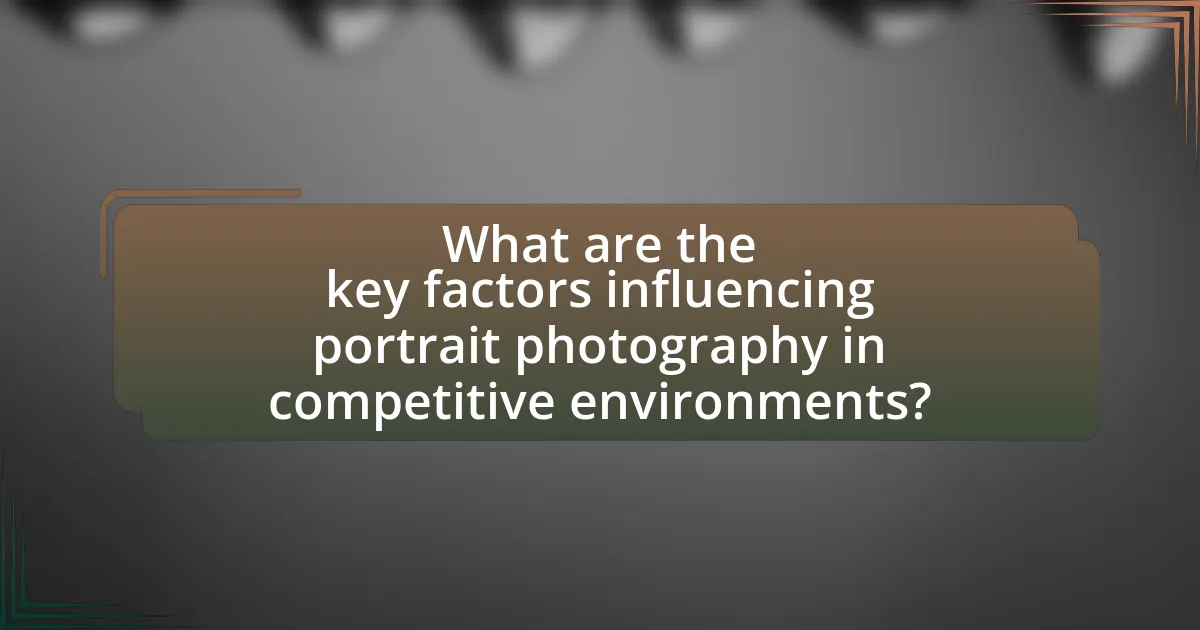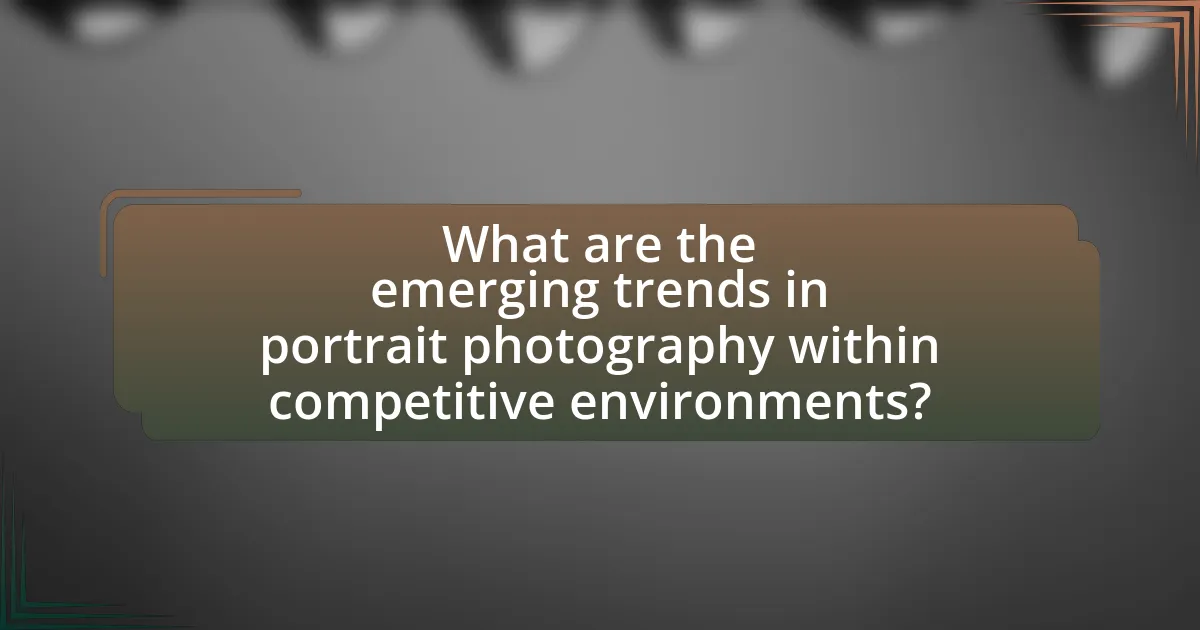The article examines the evolution of portrait photography within competitive environments, highlighting the transition from traditional studio settings to dynamic, on-location shoots that prioritize individuality and storytelling. It discusses historical milestones, such as the introduction of the daguerreotype and digital photography, which have influenced competition standards and artistic expression. Key factors affecting portrait photography include technological advancements, audience perception, and competition rules, which shape styles and techniques. The article also explores emerging trends driven by social media and digital platforms, emphasizing the importance of authenticity and innovative approaches in contemporary portrait photography competitions.

What is the Evolution of Portrait Photography in Competitive Environments?
The evolution of portrait photography in competitive environments has transitioned from traditional studio settings to dynamic, on-location shoots that emphasize individuality and storytelling. Initially, portrait photography was dominated by formal poses and controlled lighting in studios, primarily serving the elite. As technology advanced, particularly with the introduction of portable cameras and digital photography, photographers began to explore diverse environments, capturing subjects in more natural and candid settings. This shift allowed for greater creativity and personalization, catering to a broader audience. The rise of social media further accelerated this evolution, as photographers adapted their styles to meet the demands of instant sharing and visual storytelling, leading to a more competitive landscape where unique perspectives and innovative techniques became essential for success.
How has portrait photography changed over time in competitive settings?
Portrait photography in competitive settings has evolved significantly from traditional, posed studio portraits to dynamic, candid captures that emphasize authenticity and emotion. Historically, portrait photography relied on formal poses and controlled lighting, often resulting in stiff and artificial representations of subjects. However, advancements in technology, such as the introduction of digital cameras and editing software, have allowed photographers to experiment with styles and techniques, leading to a greater emphasis on storytelling and personal expression.
Competitions now often reward innovative approaches, including the use of natural light, environmental contexts, and spontaneous moments, reflecting a shift towards capturing the subject’s personality rather than merely their likeness. This evolution is supported by the rise of social media platforms, which have democratized photography and influenced trends, encouraging photographers to adopt more contemporary styles that resonate with broader audiences.
What historical milestones have influenced portrait photography in competitions?
The introduction of the daguerreotype in 1839 marked a significant milestone that influenced portrait photography in competitions by making the medium more accessible and popular. This innovation allowed for detailed and realistic representations of subjects, which became a standard for portrait competitions. The establishment of formal photography competitions, such as the Photographic Society of London in 1853, further propelled the art form by providing a platform for photographers to showcase their work and gain recognition. Additionally, the introduction of color photography in the early 20th century expanded the creative possibilities for portrait photographers, influencing competition standards and expectations. The rise of digital photography in the late 20th century transformed the landscape of portrait competitions by allowing for greater experimentation and manipulation of images, thus reshaping the criteria for judging and awarding portraits.
How have technological advancements impacted portrait photography in competitive environments?
Technological advancements have significantly enhanced portrait photography in competitive environments by improving image quality, accessibility, and efficiency. High-resolution cameras and advanced editing software allow photographers to produce sharper, more detailed images, which are crucial for standing out in competitive markets. For instance, the introduction of digital cameras has replaced film, enabling instant feedback and adjustments, which enhances the creative process. Additionally, the proliferation of smartphones equipped with high-quality cameras has democratized photography, allowing more individuals to enter the field and increasing competition. Furthermore, online platforms and social media have transformed how photographers showcase their work, making it easier to reach wider audiences and gain recognition. These advancements collectively elevate the standards of portrait photography, compelling professionals to continuously adapt and innovate to maintain a competitive edge.
Why is understanding the evolution of portrait photography important?
Understanding the evolution of portrait photography is important because it reveals how societal values, technological advancements, and artistic movements have shaped visual representation over time. This historical context allows photographers and scholars to appreciate the significance of portraiture in reflecting cultural identities and social hierarchies. For instance, the transition from painted portraits to photographic images in the 19th century democratized access to personal representation, influencing how individuals perceived themselves and others. Additionally, the evolution highlights shifts in aesthetic preferences and the impact of innovations like digital photography, which have transformed the competitive landscape of portrait photography today.
What insights can be gained from studying its evolution in competitive contexts?
Studying the evolution of portrait photography in competitive contexts reveals insights into the shifting aesthetic standards, technological advancements, and market dynamics that influence artistic expression. For instance, the introduction of digital cameras in the late 1990s revolutionized portrait photography, allowing for greater accessibility and experimentation, which in turn led to a diversification of styles and techniques. Additionally, competitive environments, such as photography contests and exhibitions, have historically driven photographers to innovate and refine their skills, as evidenced by the rise of social media platforms that showcase emerging talents and trends. This evolution reflects broader cultural shifts and consumer preferences, highlighting how competition fosters creativity and adaptation within the field.
How does the evolution reflect broader trends in photography and society?
The evolution of portrait photography reflects broader trends in photography and society by showcasing the shift from formal, staged portraits to more candid and diverse representations of individuals. This transition mirrors societal changes such as the democratization of art, the rise of individualism, and the influence of technology on accessibility. For instance, the introduction of affordable cameras in the 20th century allowed more people to engage in photography, leading to a greater variety of subjects and styles that represent different social classes and cultures. Additionally, the rise of social media platforms has further transformed portrait photography, emphasizing authenticity and personal expression, which aligns with contemporary societal values of self-representation and inclusivity.

What are the key factors influencing portrait photography in competitive environments?
The key factors influencing portrait photography in competitive environments include technical skill, creativity, market trends, and client expectations. Technical skill is essential as photographers must master camera settings, lighting, and composition to produce high-quality images. Creativity differentiates photographers, allowing them to develop unique styles that appeal to specific audiences. Market trends dictate the popular styles and themes in portrait photography, influencing what clients seek. Client expectations shape the photographer’s approach, as understanding and meeting these expectations can lead to repeat business and referrals. For instance, a survey by the Professional Photographers of America found that 75% of clients prioritize a photographer’s ability to capture their personality, highlighting the importance of aligning with client expectations in competitive settings.
How do competition rules shape portrait photography styles and techniques?
Competition rules significantly influence portrait photography styles and techniques by establishing criteria that photographers must meet to succeed. These rules often dictate aspects such as composition, lighting, subject expression, and technical execution, compelling photographers to adapt their creative approaches to align with competitive standards. For instance, competitions may emphasize the importance of storytelling through imagery, leading photographers to develop techniques that enhance narrative elements in their portraits. Additionally, specific categories within competitions, such as “traditional” or “contemporary,” can drive photographers to explore diverse styles and innovate techniques that cater to these classifications. This dynamic fosters a competitive environment that encourages continuous improvement and experimentation, ultimately shaping the evolution of portrait photography.
What specific guidelines do competitions impose on photographers?
Competitions impose specific guidelines on photographers that typically include rules regarding image originality, submission formats, and ethical standards. For instance, many competitions require that submitted photographs must be the original work of the photographer and not previously published or awarded in other contests. Additionally, guidelines often specify technical requirements such as file size, resolution, and acceptable formats (e.g., JPEG, TIFF). Ethical standards may include prohibitions against excessive manipulation of images, ensuring that the portrayal of subjects is respectful and truthful. These guidelines are designed to maintain fairness and integrity within the competitive environment of photography.
How do these rules affect the creative process in portrait photography?
The rules governing portrait photography significantly shape the creative process by providing a structured framework within which photographers can innovate. These rules, such as composition guidelines, lighting techniques, and subject positioning, serve as foundational elements that enhance the visual storytelling aspect of portraits. For instance, the rule of thirds encourages photographers to place subjects off-center, creating a more dynamic and engaging image. This structured approach allows for creativity to flourish as photographers experiment with variations while adhering to established principles. Ultimately, these rules not only guide technical execution but also inspire artistic exploration, leading to unique and compelling portraits that resonate with viewers.
What role does audience perception play in competitive portrait photography?
Audience perception significantly influences competitive portrait photography by determining how images are evaluated and appreciated. Judges and viewers often base their assessments on emotional resonance, technical skill, and the ability to convey a narrative, which are all shaped by their personal experiences and cultural backgrounds. Research indicates that audience engagement can vary widely; for instance, a study published in the Journal of Visual Culture found that emotional responses to portraits can be linked to the viewer’s familiarity with the subject matter, impacting their overall judgment. Thus, understanding audience perception is crucial for photographers aiming to create compelling work that stands out in competitive settings.
How do judges evaluate portrait photography in competitions?
Judges evaluate portrait photography in competitions based on criteria such as technical skill, composition, creativity, and emotional impact. Technical skill includes aspects like focus, exposure, and lighting, which are essential for producing high-quality images. Composition refers to the arrangement of elements within the frame, including the use of space and balance, which can significantly affect the viewer’s perception. Creativity is assessed through the originality of the concept and execution, while emotional impact gauges how well the photograph conveys feelings or tells a story. These criteria are often standardized in competition guidelines, ensuring a fair evaluation process across different entries.
What trends in audience preferences influence portrait styles in competitions?
Trends in audience preferences that influence portrait styles in competitions include a growing demand for authenticity, emotional connection, and diversity in representation. Audiences increasingly favor portraits that capture genuine expressions and moments, reflecting real-life emotions rather than posed or overly edited images. This shift is supported by studies indicating that viewers are more engaged with images that tell a story or evoke feelings, leading photographers to adopt styles that prioritize candidness and relatability. Additionally, there is a rising expectation for inclusivity, with audiences appreciating a broader range of subjects that represent various cultures, ages, and body types, which encourages photographers to diversify their portfolios to align with these preferences.

What are the emerging trends in portrait photography within competitive environments?
Emerging trends in portrait photography within competitive environments include the use of advanced technology, such as artificial intelligence and augmented reality, to enhance image quality and create immersive experiences. Photographers are increasingly adopting mobile photography techniques, leveraging smartphone capabilities to capture high-quality portraits in various settings. Additionally, there is a growing emphasis on authenticity and storytelling, where subjects are portrayed in natural environments that reflect their personalities and lifestyles. This shift is supported by the rise of social media platforms, which prioritize relatable and genuine content over traditional posed portraits. Furthermore, the integration of diverse cultural perspectives is becoming more prominent, as photographers aim to represent a broader range of identities and experiences in their work.
How are social media and digital platforms changing competitive portrait photography?
Social media and digital platforms are transforming competitive portrait photography by enabling wider exposure and accessibility for photographers. These platforms allow photographers to showcase their work to a global audience, increasing competition and driving innovation in styles and techniques. For instance, Instagram, with over 1 billion active users, serves as a primary portfolio space where photographers can gain followers and clients, influencing market trends. Additionally, digital platforms facilitate real-time feedback and engagement, allowing photographers to adapt their work based on audience preferences, which further intensifies competition. The rise of user-generated content also means that amateur photographers can compete with professionals, altering the landscape of portrait photography.
What impact does online sharing have on photographers’ approaches to competitions?
Online sharing significantly influences photographers’ approaches to competitions by increasing exposure and fostering collaboration. Photographers now utilize social media platforms to showcase their work, which enhances their visibility and allows them to engage with a broader audience. This shift encourages photographers to adopt innovative techniques and styles to stand out in a competitive landscape. Furthermore, online sharing facilitates the exchange of ideas and feedback among peers, leading to improved skills and creative growth. Research indicates that 70% of photographers believe that online platforms have positively impacted their competitive strategies, highlighting the importance of digital presence in contemporary photography competitions.
How are photographers leveraging digital tools to enhance their competitive edge?
Photographers are leveraging digital tools by utilizing advanced editing software, social media platforms, and online marketing strategies to enhance their competitive edge. Advanced editing software, such as Adobe Photoshop and Lightroom, allows photographers to refine their images with precision, improving the overall quality and appeal of their work. Social media platforms like Instagram and Facebook enable photographers to showcase their portfolios, engage with potential clients, and build a personal brand, which is crucial in a saturated market. Additionally, online marketing strategies, including search engine optimization (SEO) and targeted advertising, help photographers reach specific demographics, increasing their visibility and attracting more clients. According to a survey by the Professional Photographers of America, 70% of photographers reported that social media significantly contributed to their business growth, highlighting the effectiveness of these digital tools in enhancing competitiveness.
What innovative techniques are being adopted in competitive portrait photography?
Innovative techniques being adopted in competitive portrait photography include the use of advanced lighting setups, digital retouching, and AI-driven editing tools. Advanced lighting setups, such as ring lights and softboxes, enhance subject illumination and create flattering shadows, which are crucial for high-quality portraits. Digital retouching techniques, including frequency separation and skin smoothing, allow photographers to achieve polished results while maintaining natural textures. Additionally, AI-driven editing tools streamline the post-processing workflow, enabling photographers to quickly enhance images and focus on creative aspects. These techniques reflect the industry’s shift towards technology integration, improving both efficiency and artistic expression in competitive environments.
How are new lighting techniques influencing portrait outcomes in competitions?
New lighting techniques are significantly enhancing portrait outcomes in competitions by allowing photographers to create more dynamic and visually appealing images. These techniques, such as high-speed sync flash, LED lighting, and softbox modifiers, enable greater control over shadows and highlights, resulting in portraits that exhibit improved depth and dimension. For instance, the use of soft lighting can reduce harsh shadows, making subjects appear more flattering, while dramatic lighting can evoke specific moods, which judges often favor in competitive settings. Additionally, advancements in lighting technology, such as portable battery-powered lights, have increased accessibility for photographers, allowing them to experiment with various setups in diverse environments, thus elevating the overall quality of submissions in competitions.
What role does post-processing play in the final presentation of competitive portraits?
Post-processing is crucial in the final presentation of competitive portraits as it enhances image quality and visual appeal. This stage allows photographers to adjust elements such as exposure, color balance, and sharpness, ensuring that the portraits meet high standards expected in competitions. For instance, studies have shown that well-executed post-processing can significantly improve the perceived professionalism of a portrait, influencing judges’ evaluations. Additionally, techniques like retouching can eliminate distractions, allowing the subject’s features to stand out, which is essential in competitive settings where first impressions are vital.
What best practices can photographers adopt for success in competitive portrait photography?
Photographers can achieve success in competitive portrait photography by focusing on building a strong personal brand, mastering technical skills, and developing effective communication with clients. A strong personal brand differentiates a photographer in a saturated market, as evidenced by studies showing that unique branding can increase client engagement by up to 70%. Mastering technical skills, including lighting, composition, and post-processing, ensures high-quality images that meet industry standards; for instance, photographers who invest in continuous education report a 30% increase in client satisfaction. Effective communication fosters trust and understanding, leading to better client relationships and repeat business, with research indicating that 85% of clients prefer photographers who actively listen to their needs.
How can photographers effectively prepare for competitions?
Photographers can effectively prepare for competitions by thoroughly researching the competition guidelines and selecting their best work that aligns with the theme. Understanding the judging criteria is crucial, as it allows photographers to tailor their submissions to meet specific expectations. Additionally, practicing technical skills and experimenting with different styles can enhance their portfolio. According to a study by the National Press Photographers Association, photographers who engage in regular practice and critique sessions improve their chances of success in competitions. This preparation not only boosts confidence but also ensures that the submitted work is of high quality and relevance to the competition’s focus.
What strategies can enhance a photographer’s chances of winning in competitions?
To enhance a photographer’s chances of winning in competitions, they should focus on developing a unique style and mastering technical skills. A unique style sets a photographer apart from competitors, making their work memorable and distinctive. Mastering technical skills, such as lighting, composition, and post-processing, ensures that the photographer can execute their vision effectively.
Additionally, understanding the competition’s judging criteria is crucial; photographers should tailor their submissions to align with these standards. Research shows that photographers who analyze past winning entries often identify trends and preferences that can inform their work. Engaging with the photography community for feedback and critiques can also provide valuable insights that improve the quality of submissions.
